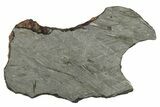6.58" Etched Iron Meteorite Slice (252.5 g) - Chad
This is a 6.58" wide (252.5 gram) etched slice of a IIIAB iron meteorite found this past year in Chad. This meteorite is currently under formal classification so it should have a name fairly soon. Originally it was listed as coming from Sudan but after GPS coordinate of the find location were received it was found to be just across the border in Chad.
It shows a very nice Widmanstätten patterns and fully stabilized through reverse electrolysis and coated to prevent rusting. It comes with an acrylic display stand.
It shows a very nice Widmanstätten patterns and fully stabilized through reverse electrolysis and coated to prevent rusting. It comes with an acrylic display stand.
About Iron Meteorites
Iron type meteorites are composed primarily of iron and nickel, and are the remnants of differential cores torn apart at the beginning of the solar system. These metallic meteorites are often the easiest to identify after millions of years post-impact because they are quite different from terrestrial material, especially when it comes to their mass-to-surface area ratio. They are exceptionally heavy for their size since iron is a high-density metal: this is also why the Earth's core is nickel-iron. As planets form, the densest metals form gravitational centers, bringing more and more material into their gravitational pull. In the solar system's rocky planets, these dense materials are most often nickel and iron.
Most iron meteorites have distinctive, geometric patterns called Widmanstätten patterns, which become visible when the meteorite is cut and acid etched. These patterns are criss-crossing bands of the iron-nickel alloys kamacite and taenite that slowly crystalized as the core of the meteorites' parent bodies slowly cooled. Such large alloy crystallizations for mover millions of years and do not occur naturally on Earth, further proving that iron meteorites come from extraterrestrial bodies.
Iron type meteorites are composed primarily of iron and nickel, and are the remnants of differential cores torn apart at the beginning of the solar system. These metallic meteorites are often the easiest to identify after millions of years post-impact because they are quite different from terrestrial material, especially when it comes to their mass-to-surface area ratio. They are exceptionally heavy for their size since iron is a high-density metal: this is also why the Earth's core is nickel-iron. As planets form, the densest metals form gravitational centers, bringing more and more material into their gravitational pull. In the solar system's rocky planets, these dense materials are most often nickel and iron.
Most iron meteorites have distinctive, geometric patterns called Widmanstätten patterns, which become visible when the meteorite is cut and acid etched. These patterns are criss-crossing bands of the iron-nickel alloys kamacite and taenite that slowly crystalized as the core of the meteorites' parent bodies slowly cooled. Such large alloy crystallizations for mover millions of years and do not occur naturally on Earth, further proving that iron meteorites come from extraterrestrial bodies.
$1,125
TYPE
Iron, IIIAB
AGE
LOCATION
Chad
SIZE
6.58 x 4.3", 0.12" thick, Weight: 252.5 grams
CATEGORY
ITEM
#272593
 Reviews
Reviews











